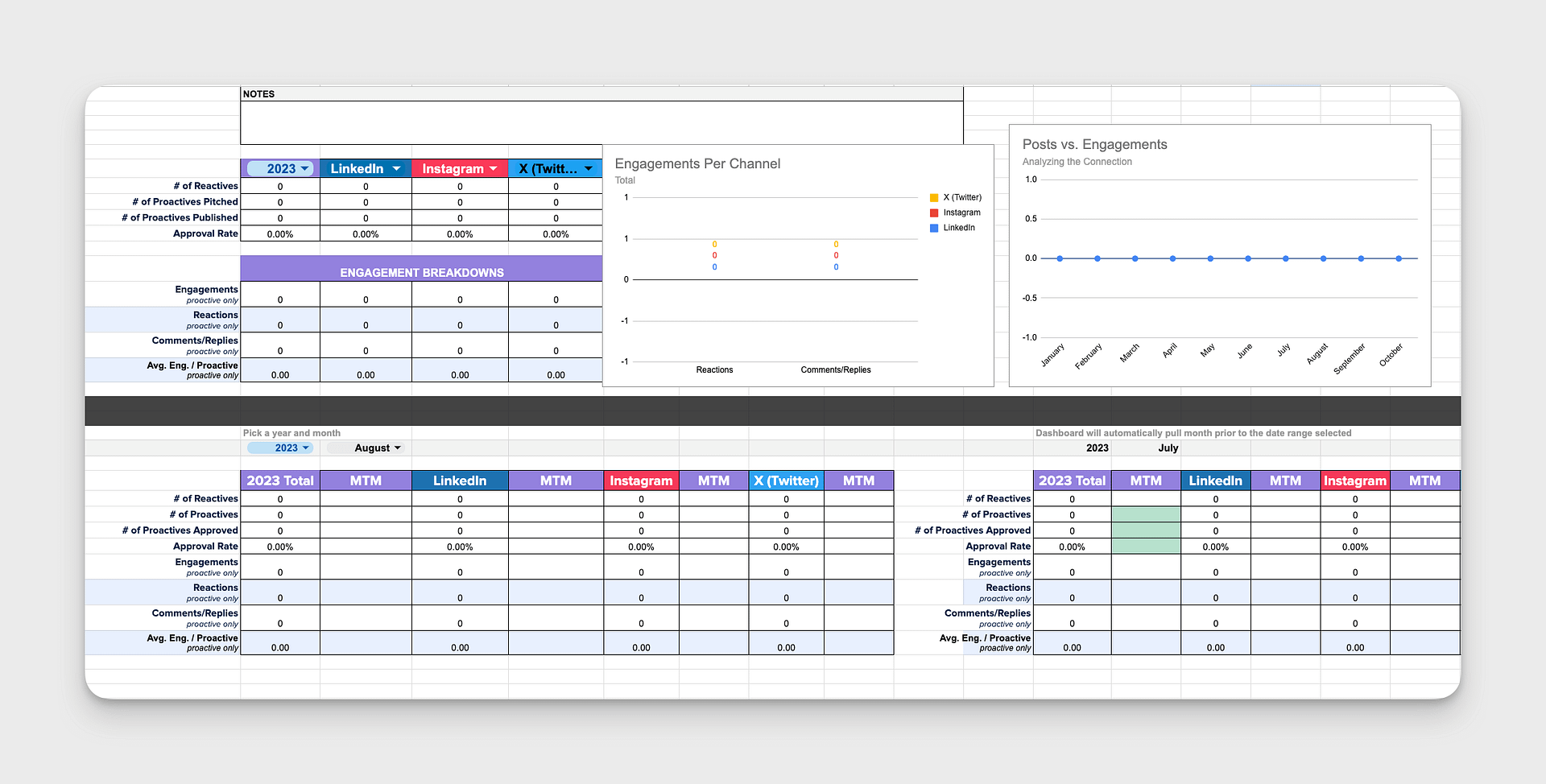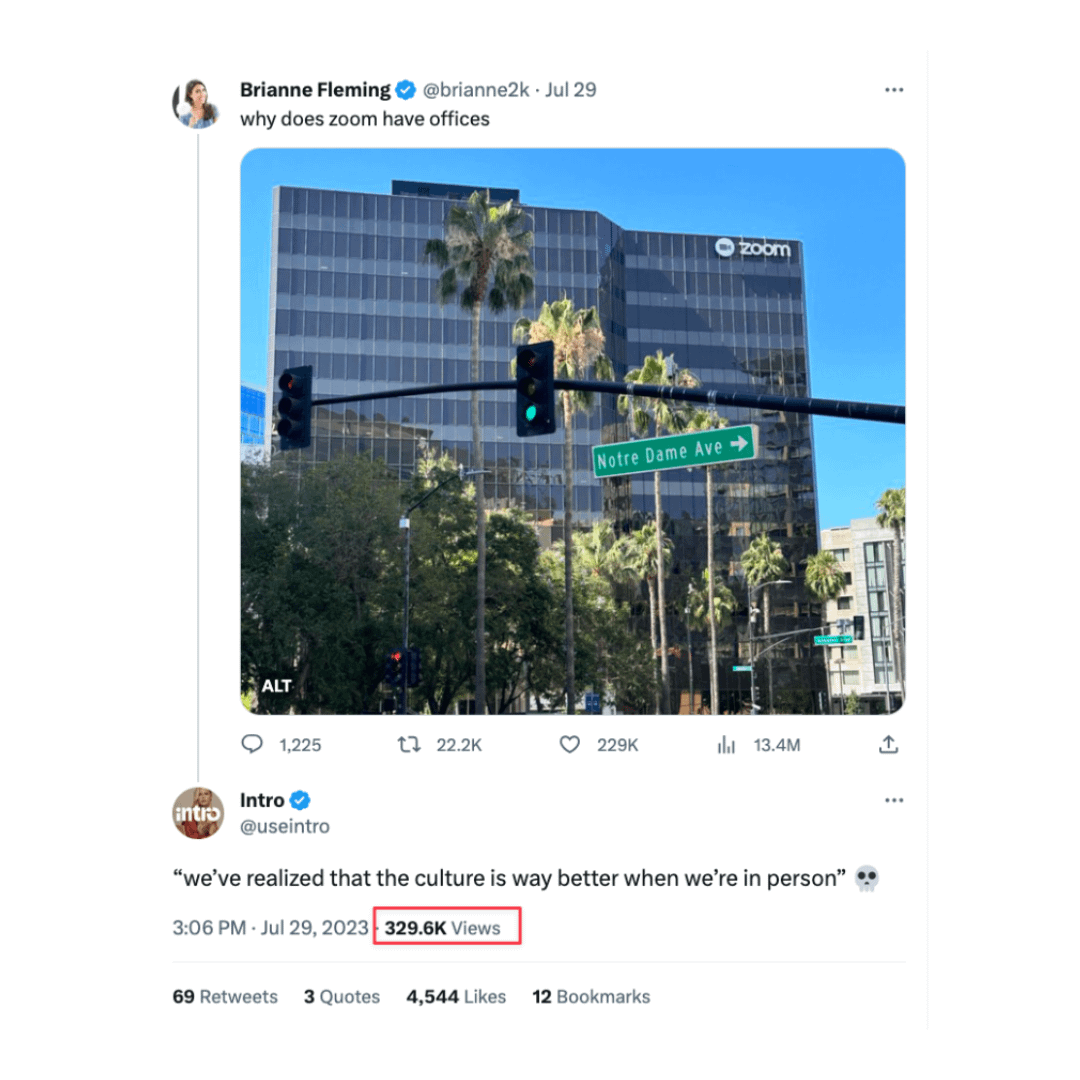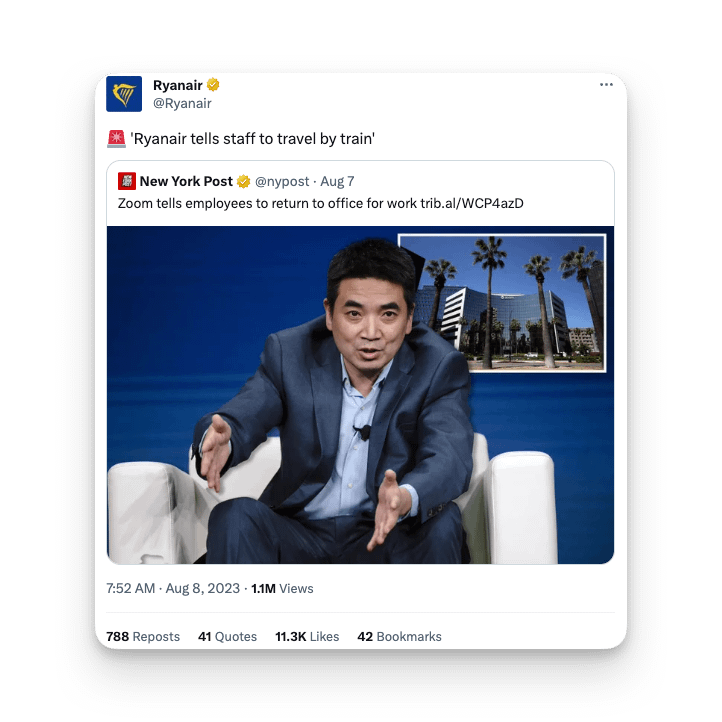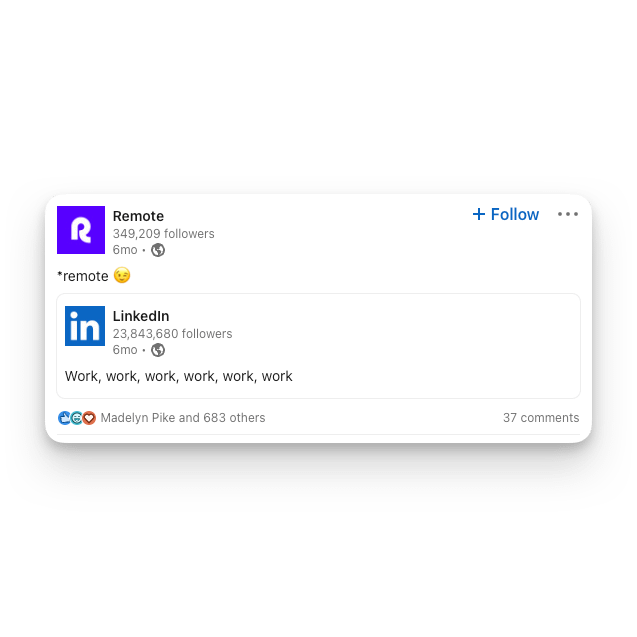Posted 01.05.2024 by Josh Krakauer
Social Media Engagement Strategy: Why the Comment is the Content
Learn how proactive social media engagement strategies drive viral reach and why the comment is the king of social media content.
There’s a simple formula when it comes to engaging in social media: when your audience talks, you respond. By providing timely, appropriate answers, you’ll keep people engaged and entertained with the hope of converting customers into advocates.
Sometimes, though, simple ≠ easy. For that, we’re here to help.
Community management consists of two main players: reactive engagement and proactive engagement.
Reactive social media engagement is the easier one to manage, and you’re probably familiar with it. Reactive engagement means responding to questions, comments, and tags of your brand across social media channels. It’s essentially for keeping the lights on.
Think of it like reputation management. Done well you can expect a low to medium (positive) impact on your brand reputation and social media KPIs.
When not done at all, there is potential for major issues, particularly when it comes to interactions that are related to customer experience.
Today, we’re focused on being proactive.
Proactive social media engagement can add tremendous value to your brand and its social presence. If done well, proactive community management can have a large impact on social media KPIs, without the major brand risk if you ignore it.
Being proactive in community management is crucial for enhancing brand reputation AND earning mentions and reach.
For today’s lesson, we’re going to chat all about this “leveling up” side of social media. So, get comfy, pull out your trusty binder, grab that Ticonderoga pencil full of bite marks, and let’s dive right in.
What is Proactive Social Media Community Management?
Proactive community management involves taking a proactive and forward-thinking approach to nurturing and engaging with your social media communities.
Proactive community management is also called outbound engagement, proactive engagement, or simply proactive outreach.
- But wait! 🛑 It goes beyond just responding to inquiries and concerns (a simple “Great Post” will not work here!) and instead focuses on:Initiating conversations.
- Fostering relationships.
- Providing valuable content and experiences.
By implementing this approach, we empower ourselves to be at the forefront of community social dynamics, anticipating needs, and consistently delivering value.
How does proactive community management work? 🤔
By engaging in proactive conversations, you’ll be strengthening your brand’s association with relevant topics, and also establish yourself as a trusted source of information.
The driving force behind the engagement strategy comes from the power of “comments as content.”
What does that mean?
In modern social media platforms, comments drive reach. When someone you follow comments on a LinkedIn post, that comment creates a story in the feed.
The conversations you generate within the community become valuable content themselves, often reaching a wider audience than our external outbound posts!
When a post goes viral, the comments underneath the original post become content in itself — often earning tens, hundreds, of thousands of reactions.
Setting a proactive engagement strategy
“A vision without a strategy remains an illusion.” – Lee Bolman
A solid strategy is what will separate “future” you from “current” you when it comes to a robust community management service.
Our strategy at Sculpt is simple and works for us. Take what we’re saying and adjust it to fit your needs (we promise it won’t hurt our feelings).
Our Standard Operating Procedure (SOP) is this: Voice, Objective, Workflow.
Establish Voice Guidelines
Imagine if your brand could walk, talk, and hang out at a party. How would it sound? What kind of jokes would it crack?
That right there is your brand voice!
It’s the unique flavor of your brand’s personality in every chat you have with your customers. Think of it as the secret ingredient in your marketing recipe that helps you become the best friend of the people who need or want what your brand’s cooking up.
Different brands approach brand voice with differing levels of detail. For instance, Slack describes its voice as clear, concise, and human. In its writing guidelines, it highlights voice and tone examples, copy principles, stylization, and usage across marketing.
At a high level, aim to describe the overarching attributes of your voice in 3-5 words.
Set an Engagement Goal
Now that you’ve gotten your voice down and can talk the talk, who do you want to walk the walk with? That’s what you need to narrow down your objective. Who are you trying to reach and why?
Throwing spaghetti at a wall is fun and all, but it’s not the best way to make a good meal. Figure out who/what/why you are actively pursuing proactive engagements that will efficiently help plate and deliver your meal to your audience.
Examples of proactive engagement objectives include:
- Thought leadership: Responding to industry conversations that amplify your point of view as an expert in that category.
- Acquiring customers: Responding to prospects asking about solutions to problems you solve, or talking about competitors.
- Driving traffic: Responding to conversations about topics you’ve written about with a helpful resource you can link to.
- Earned reach and engagement: Responding to relevant high-reach posts, or relevant creators to earn positive brand awareness (impressions) and reactions (engagement) from their followers.
Track Engagement Results
So you’ve found your voice, know your objective, and are lost on where to go from here.
Unlike reactive responses when someone mentions your brand, proactive engagements can not be easily tracked using your standard social media management tool of choice (with X being the exception).
To go around this we recommend building a proactive engagement tracker — a manually-fed spreadsheet that organizes your responses. If you’re well-versed in workflow automation, some platforms (such as Facebook and LinkedIn) will allow you to automatically track a number of metrics, including share, page, and follower statistics (on LinkedIn), and reactions (on Facebook).A standard engagement tracking workflow should be along these lines:
- Identify the engagement opportunity.
- Add the link to the opportunity in your proactive tracker (we’ll expand on this in a bit).
- Draft your response copy and place it into the tracker.
- Optional: Send the response for approval. This could be your boss, your legal team, or your client (if you’re an agency like us).
- Mark responses as approved or “disapproved”, and why.
- Document the number of reactions to your comment by type — one week to one month later. This gets rounded up for reporting and future learning.
Executing the proactive engagement strategy
The hard part is done (setting the strategy) now let’s get to cookin’ and execute the strategy.
There are three main steps to managing a proactive engagement strategy:
- Listening.
- Engaging.
- Tracking.
Let’s get under the hood.
1. Listening
You’ve narrowed down your tone of voice, found your objective, and hashed out your workflow. The goal of listening is to find your audience and the conversations they are having.
There are several methods that you should be using to find these convos:
- Utilize relevant hashtags/keywords and native search tools (including advanced search features).
- Actively following key players in the industry.
- Actively following top brands as well as competitors within your industry.
For example, for Remote.com, we searched for conversations on LinkedIn around remote working so that we could interject our voice and either provide a POV/thought leadership or engage for relevant reach.
How to Search for Proactive Engagement Opportunities on Social Media
There are two ways based on the platform: natively, or with third-party tools.
Monitoring on native platforms: For API-restrictive platforms like LinkedIn or X, this is the way. Take your list of saved keywords and sort the feed to find standout posts.
Monitoring with social listening tools: You can use social listening platforms that actively search for you and deliver the most up-to-date and relevant content. For platforms like Instagram, this can save you time.
2. Engaging
Now comes the fun part! 🥳
By now, you should know how to properly engage with individuals based on the strategy per client and the tone of voice (ToV) that you narrowed down earlier.
The engagement phase is where the rubber meets the road — writing the right response at the right time.
How many responses should you deliver in a week? This depends on how active your industry is and how aggressive your engagement goals are.
In the beginning, aim for ~2 responses per day, and gradually increase. Why? The more you respond, the more you learn what resonates. And the more shots on goal, the more likely you hit it!
What types of responses should you make? This will depend slightly on your brand, but most likely this will be an array of content: videos, photos, gifs, memes, and especially plain text.
The rule of course is to understand the context of the comment, match the tone, and personalize it accordingly. Use your instincts. Are you jumping for joy in the comment of a serious statement? Are you getting technical underneath a parody post? Let’s not.
When should you be engaging? For community management, timeliness is the name of the game. If you can swing it, the best plan is to schedule monitoring blocks multiple times per day — for instance, beginning, middle, and end of the day.
That way you increase the chance you find posts at the beginning of the trend cycle. Preferably, you will hop on posts early when they are still gaining traction. Ride that train free of charge!
3. Tracking
Success comes from a consistent cadence of testing and learning.
Here at Sculpt, we have created an awesome engagement tracker that we are happy to share with you! Why? Because hot agencies don’t gatekeep. 💅
The tracker is fairly straightforward, only needing a handful of inputs: name, dates, links, and total engagements inputted when desired. From there on out, let the machine do the work!
The tracker spits out data showing approval rates, total engagements, MoM analytics, and amounts. Armed with the tracker, you actively have your finger on the pulse of your community, which allows you to make key data-driven decisions.
Bonus: Get the response tracker template [free!]
Start documenting and reporting on your proactive engagement strategy today.

What Makes a Successful Community Engagement Program?
The path to good and effective proactive community management is full of trials and tribulations…luckily for you, we’ve been on the path for a while.
Here are our top five methods to ensure success.
1. See Something, Share Something
Odds are that you have coworkers who understand the pulse of your audience and use social media every day. RELY ON THEIR EXPERTISE.
At the end of the day, you are one person with two eyes and limited bandwidth.
Tap into your team to keep an eye out for holidays, cultural moments, events, trending stories, and brand, or customer mentions that you might have missed.
Pro tip: We have a dedicated Slack channel for this.
2. Revel in the Relevance
It should come as no surprise, but the easiest way to be on top of community management is to ensure your community manager is on top of internet trends and culture.
So, if you need another reminder to be thoroughly involved in the world of social as well as the world of your customers, here it is.
3. Speed Matters: Get Pre-approvals
Do you remember S1E7 of The Bear when all hell breaks loose because there are too many chefs in the kitchen?
Ya, avoid that.
The goal of proactive community management is to have the right response at the right time.
To nail the timeliness, establish the approval workflow in advance. If your perfect response to a ‘happening now’ conversation needs to change hands five times for approval, you’ve lost the game.
Establish the criteria for what needs approval, and what can be acted on quickly. The difference between a viral reply and a floppy flop could be a few hours.
Pro tip: To speed up the process, give approvers options to pick from rather than creating an open discussion or endless revisions.
4. Confidence is Your Middle Name
Community Managers need to be confident in their responses. After all, you are in this position for a reason: you’re amazing at your job, and you know what your audience likes too.
Being confident is trusting your gut and knowing when to hit publish and just as importantly, when NOT to pursue a trend.
5. Get Your Reps In
The math is simple: more responses = increasing the “luck surface area” (and also the chance you get a winning reaction).
Find a balance between quality, quantity, and volume.
The more responses that you push out, the more you learn what works and what doesn’t.
If Wayne Gretzky were a community manager, we assume he’d say something along the lines of “You miss 100% of the post engagements you don’t publish”.
Now let’s look at a few companies that are just plain ✨crushing it✨ with Proactive Community Management
Intro
Let’s set the stage: Zoom, the company we remote folks have grown to know and love, for some reason, has offices. Like, real, physical, sprawling office space.
X user Brianna Fleming called that out.
Intro (a company used to connect individuals to professionals) was fast to hop on and delivered the perfect comeback, garnering over 329k views and 4,500 likes. Further proof that the comment is the content!


Ryanair
The ultra-low-cost airline company, Ryanair, doesn’t skip a beat when it comes to unhinged proactive community management. Their X replies are a gold mine, their TikTok interactions never miss, and they are just all about audience entertainment. They do an amazing job of being relevant, having tongue-in-cheek language, and most importantly…being timely.
Remote
We may be a bit biased with this one, but we’re throwing it in anyway.
Remote.com offers global employment of record (EOR) services to help businesses onboard, offer benefits, and pay workers around the world. Remote tasked us with handling their proactive engagement to expand its voice and reach in a competitive category — and we had some fun with it!
What worked: Find the conversation, drive the conversation. Every day brings a new trending post in the #RemoteWork topic. Sculpt paired new content pillars with proactive engagement strategies that connected Remote to global communities of remote professionals, including influencers, customers, and advocates.
When a timely, topical post made a splash on the platform, we helped Remote ride the wave in the comments. After responding to hundreds of posts — the community took notice.
The result: Beyond follower growth and a lift in monthly average LinkedIn interactions, Remote generated thousands of engagements (comments, reactions) earned from proactive replies.
At the end of the day, we stayed in between the lines of both brand guidelines and brand voice/ToV, luckily for us, those lines are wide! Here’s one of our faves.

